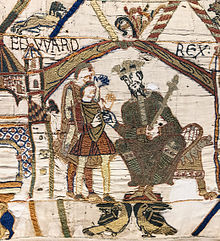Edward the Confessor
| Edward the Confessor | |
|---|---|

EDWARD(US) REX: Edward the Confessor, enthroned, opening scene of the Bayeux Tapestry
|
|
| King of the English | |
| Reign | 8 June 1042 – 5 January 1066 |
| Coronation | 3 April 1043, Winchester Cathedral |
| Predecessor | Harthacnut |
| Successor | Harold Godwinson |
| Born | 1003 Islip, Oxfordshire, England |
| Died | 5 January 1066 (aged about 62) London, England |
| Burial | Westminster Abbey, England |
| Spouse | Edith of Wessex |
| House | Wessex |
| Father | Æthelred the Unready |
| Mother | Emma of Normandy |
| Religion | Catholicism |
| Saint Edward the Confessor | |
|---|---|
 |
|
| King of England, Confessor | |
| Born | 1003 Islip, Oxfordshire, England |
| Died | 5 January 1066 (aged about 62) London, England |
| Venerated in |
Roman Catholic Church Eastern Orthodox Church Anglican Communion |
| Canonized | 1161, Rome by Pope Alexander III |
| Major shrine | Westminster Abbey |
| Feast | 13 October |
| Attributes | King crowned with nimbus, sceptre, martlet |
| Patronage | Difficult marriages; England (before 1347); English Royal Family; Kings |
Edward the Confessor (Old English: Ēadweard Andettere, Latin: Eduardus Confessor; 1003 – 5 January 1066), also known as Saint Edward the Confessor, was among the last Anglo-Saxon kings of England, and usually considered the last king of the House of Wessex, ruling from 1042 to 1066.
The son of Æthelred the Unready and Emma of Normandy, Edward succeeded Cnut the Great's son – and his own half brother – Harthacnut, restoring the rule of the House of Wessex after the period of Danish rule since Cnut (better known as Canute) conquered England in 1016. When Edward died in 1066, he was succeeded by Harold Godwinson, who was defeated and killed in the same year by the Normans under William the Conqueror at the Battle of Hastings. Edgar the Ætheling, who was of the House of Wessex, was proclaimed king after the Battle of Hastings in 1066, but never ruled and was deposed after about eight weeks.
As discussed below, historians disagree about Edward's fairly long (24 year) reign. His nickname reflects the traditional image of him as unworldly and pious. Confessor reflects his reputation as a saint who did not suffer martyrdom, as opposed to King Edward the Martyr. Some portray this king's reign as leading to the disintegration of royal power in England and the advance in power of the House of Godwin, because of the infighting after his heirless death. Biographers Frank Barlow and Peter Rex instead portray Edward as a successful king, who was energetic, resourceful and sometimes ruthless, arguing that the Norman conquest shortly after his death tarnished his image. However, Richard Mortimer argues that the return of the Godwins from exile in 1052 "meant the effective end of his exercise of power", citing Edward's reduced activity as implying a withdrawal from affairs".
...
Wikipedia
